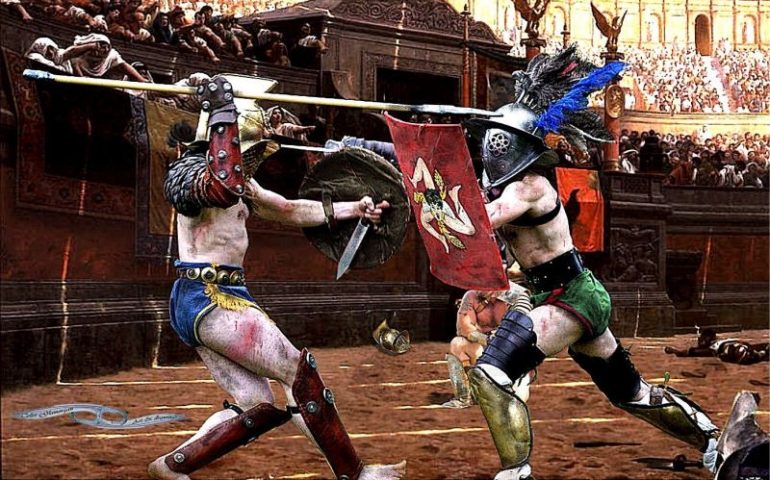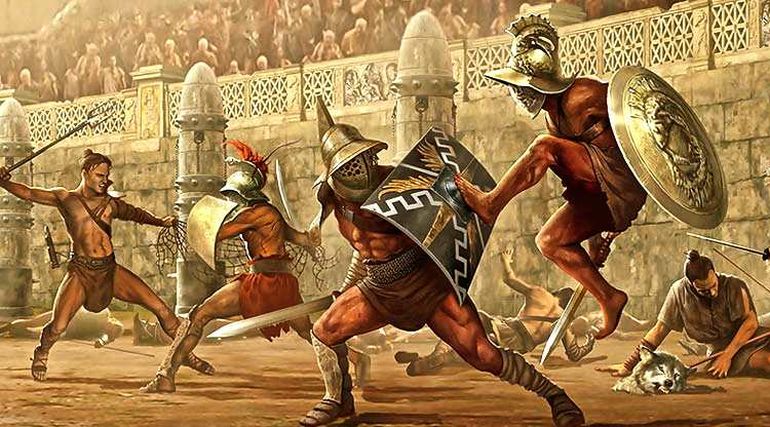What happened in gladiator fights?
Who really were the gladiators and what really happened in the Colosseum in Rome and in the other amphitheaters of the Roman Empire? The name “gladiators” derives from gladius, the sword of the past Roman legionary that they also use by wrestlers.

The practice of duels between gladiators comes from the Etruscans and like many other aspects of Etruscan culture, this too was adopted by the Romans.

The first gladiator show probably took place in 264 BC. In 105 BC the games became public.

The gladiators were on average between 20 and 35 years old (in the majority, however, 30), in line with the life expectancy of the time. And the height was also in line with the time: 168 cm.
The fighters could be real professionals, new inexperienced gladiators, convicts, criminals, slaves, convicts, prisoners of war, Christians, or free men, without distinction of race or sex (the fights of gladiators, extremely rare, were however always the most requested).

Gladiators were trained in special schools. The most prestigious was the Ludus Magnus.
The gladiators stayed in cells arranged according to an internal hierarchy of the school. Together with a magister, the fighters were judged for skill and physical prowess and assigned to different categories.
They underwent rigorous daily workouts and a diet based mostly on vegetables, legumes, honey and dairy products. Before entering the arena they ate a honey focaccia to get more energy.

The games in the arena always started with a parade. The first to enter was the financier along with attendants with signs with the day’s program. The slaves carried the weapons of the fighters. So it was the turn of the gladiators and those sentenced to death. After greeting the emperor, the fighters went to take up arms.
The main categories of Gladiators were: the Mirmillone: with heavy armor consisting of helmet and integral shield. II Thrace: gladiator who possessed a curved sword, with a small and light shield. The Secutor: called pursuer. He was heavily armored, with a padded helmet. He was called that because he was chasing the opponent. The retiarius: used a net with weights, a dagger and a trident. Among the gladiators he was the lowest class because he fought only with the tunic. Among the people, however, he was much loved because people could see his face.
The gladiator who had beaten his opponent turned to the audience of the amphitheater to ask his fate and the crowd, with a sign of the hand, decided for death or for life: the thumb pointing up, “mitte” ( safe) meant he had to live and thumb pointing down, “jugula” (death) meant he had to die. In the end, however, it was the emperor or whoever organized the show in question who determined the fate of the defeated gladiator with his thumb.
Each gladiator killed cost a very high sum to the one who organized the show and, clearly, they did not easily ask for their death.
The gladiator fights were inspired by mythological episodes; grotesque situations were also staged that amused and excited the crowd at the same time.
Then there were the venationes, which were the fights between gladiators and animals.
Among the animals that have appeared in the venationes are lions, tigers, leopards, elephants, bears, deer, wild goats and camels. Respected for its ferocity, the lion was extremely popular during venationes and gladiator shows. Pompey set a macabre record by killing 600 lions.
The gladiator had a difficult and very risky life. He fought for life, for freedom and for glory and the Roman people appreciated and remained fascinated by the strength and courage of the winning gladiator who became a famous person.
Convicts and prisoners of war, particularly fierce for having survived years of struggle and suffering, were much sought after for the struggle. Very often they were originally from distant lands (for example Numidia, Thrace, Germany), and willingly proposed themselves, so that they could progress in this career.
Most of the gladiators were in fact slaves or ex slaves, but also as mentioned free-born individuals who fought under contract with a “manager”. They were often regarded as prostitutes, actors and pimps, and generally outcasts. Often accompanied by the definition of “infames” (people of bad reputation).
An article by Focus reports that based on a study, the analysis of the wounds found on the skeletons seems to confirm what historians have been saying for some time: the fights between gladiators were not mere clashes to the massacre, made of blind violence and mutilation, but they were real wrestling matches, with precise rules whose application was guaranteed by the presence of referees.
Although the wrestlers used sturdy helmets, wounds were found on the remains of 10 skulls, the cause of which is attributable to a blow with a hammer. According to the researchers, these remains belong to fighters who, after losing the match, were put to death by the public or by notables, as was the custom of the time. From the reconstruction it seems that these gladiators were brought out of the arena still alive and killed in the wings with a hammer blow from an executioner. A truly inglorious end.
The number of gladiatorial shows increased enormously during the Empire.
The Flavian dynasty, which began with the Emperor Vespasian, built the largest and most famous amphitheater in the world, the Flavian amphitheater, later known from the Middle Ages as the Colosseum. In the fourth century, Emperor Constantine I, after embracing the Christian faith, prohibited them.
The bad reputation, however, benefited the gladiators, real sex symbols of their time. Also loved by women of the nobility, who were willing to do anything for the love of a gladiator. Like Eppia, wife of a senator, whom she abandoned her husband to escape with a hero of the arena.
